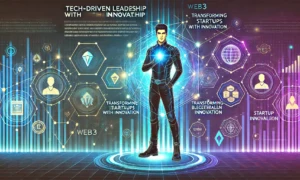The rapid pace of innovation has brought several emerging technologies to the forefront, transforming industries and reshaping societal norms. This case study explores some of the most trending technologies today—Artificial Intelligence (AI), Blockchain, Quantum Computing, Biotechnology, and Extended Reality (XR)—and examines their real-world applications, challenges, and implications.
Introduction: The Landscape of Emerging Technologies
Emerging technologies are those that are in their early stages of adoption but show immense potential for growth and impact. They often act as catalysts for economic, social, and environmental transformation. Key factors driving their adoption include the increasing availability of data, advances in computational power, and the global push for sustainability.
Case Study: Top Trending Technologies
1. Artificial Intelligence (AI)
- Trend: AI continues to dominate discussions due to its expanding capabilities in machine learning, natural language processing (NLP), and computer vision.
- Application:
- Healthcare: AI-powered tools analyze medical images to detect diseases like cancer earlier and more accurately than traditional methods.
- Business: Chatbots and virtual assistants enhance customer service efficiency.
- Case Example: Google DeepMind used AI to predict protein folding structures, accelerating drug discovery and personalized medicine development.
- Impact: Increased efficiency across industries and groundbreaking discoveries in science and medicine.
2. Blockchain
- Trend: Originally known for cryptocurrencies like Bitcoin, blockchain is now being adopted for secure, decentralized data management across industries.
- Application:
- Finance: Enables secure, transparent transactions without intermediaries.
- Supply Chain: Tracks goods in real-time, ensuring authenticity and reducing fraud.
- Case Example: Walmart uses blockchain to track food products, ensuring transparency and reducing the risk of contamination in the supply chain.
- Impact: Enhanced trust, security, and efficiency in various sectors.
3. Quantum Computing
- Trend: Quantum computing is gaining traction as companies and governments invest heavily in this next-generation technology.
- Application:
- Cryptography: Develops quantum-resistant encryption to counteract the security challenges posed by quantum computers.
- Optimization: Solves complex logistical problems in industries like transportation and supply chain management.
- Case Example: IBM successfully simulated small molecules, demonstrating the potential for quantum computers to revolutionize drug discovery.
- Impact: Opens new possibilities in problem-solving, but its widespread adoption is limited by hardware challenges.
4. Biotechnology
- Trend: With advances like CRISPR gene editing and synthetic biology, biotechnology is reshaping healthcare, agriculture, and environmental management.
- Application:
- Healthcare: Gene editing technologies treat genetic disorders and develop personalized medicine.
- Agriculture: Engineered crops resist pests and adapt to climate change.
- Case Example: Editas Medicine used CRISPR to develop therapies for genetic blindness, showcasing the life-altering potential of biotechnology.
- Impact: Enhanced quality of life, improved food security, and sustainable solutions for global challenges.
5. Extended Reality (XR)
- Trend: XR, which includes Virtual Reality (VR), Augmented Reality (AR), and Mixed Reality (MR), is emerging as a transformative tool in education, entertainment, and remote work.
- Application:
- Education: VR simulations provide immersive learning experiences.
- Workspaces: AR tools facilitate remote collaboration and training.
- Case Example: Meta launched Horizon Workrooms, enabling teams to collaborate in virtual environments that mimic real-life interactions.
- Impact: Redefines how people learn, work, and interact with digital content.
Challenges of Emerging Technologies
- Scalability: Many technologies face infrastructure and cost barriers that limit widespread adoption.
- Ethical and Privacy Concerns: AI biases, gene editing ethics, and blockchain data privacy raise societal concerns.
- Interoperability: Ensuring seamless integration between technologies, such as IoT and AI, remains a challenge.
- Regulation and Policy: Governments struggle to create frameworks that balance innovation with safety and ethics.
Future Directions
- Convergence of Technologies
- The integration of AI with blockchain, biotechnology, and quantum computing could create synergistic solutions for complex global challenges.
- Focus on Sustainability
- Technologies like AI-driven energy optimization and biotechnological advances in renewable resources will play a crucial role in combating climate change.
- Human-Centric Design
- As these technologies evolve, ensuring they enhance human well-being and reduce disparities will be a priority.
- Global Collaboration
- International partnerships will be essential to overcome technical, ethical, and regulatory challenges.
Conclusion
Trending emerging technologies like AI, blockchain, quantum computing, biotechnology, and XR are driving unprecedented changes across industries. While each technology has its unique potential, their convergence could define the next era of innovation.
However, realizing their full potential requires addressing scalability, ethical, and regulatory challenges. As these technologies mature, they will continue to reshape the world, offering solutions to humanity’s most pressing problems while creating new opportunities for growth and development.
Disclaimer
Posts in the Notebook are written by individual members and reflect personal insights or opinions. Please verify any information independently. If you have any concerns, notify the admin immediately so we can take action before any legal steps are taken.





